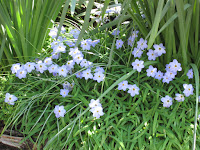The Wilmington paper ran an article in today's features section about bulbs. It was an okay piece, I guess, although I disagreed with many of its points, starting with the author’s mail-ordering her stock from Brecks of Indiana instead of somewhere in the southeast. (See my November 16th posting for the importance of provenance when it comes to bulbs.) Also took issue with several of the expert’s recommendations. But then, I’m a querulous sort and absolutely not a fan of 10-10-10 fertilizer, a topic for another day.
 |
| Species tulip Tulipa turkestanica |
My biggest gripe, though, was with same old tired genera suggested. Don’t get me wrong—I’m a huge fan of daffodils, all 13 of their divisions. For your information, the fragrant jonquils, tazettas and cyclamineus types perform best in mild-winter areas. I also love the miniatures: there’s just something about a perfect dainty daff that’s only four or five inches high. The split corona hybrids are, if you’ll pardon the pun, growing on me. Be that as it may, what really gets me bulbously excited are the lesser-known varieties.
Remember those ten crates I mentioned last time? They contained about 3000 individual bulbs. And yes, most—about 2200—were daffs. But the other 800 are the ones that really tickle my fancy.
Everybody knows hybrid tulips, those crayon-colored icons of high spring. In mild-winter areas, however, the lack of long bouts of below-freezing temperatures provides insufficient chilling for them to perform well except as annuals. What everybody doesn’t know is that there are several straight species, smaller-flowered than the blowsy hybrids, that do better hereabouts. Last fall, I planted 50 each of white-and-yellow T. turkestanica, red-and-yellow T. clusiana var. chysantha, red-and-black T. linifolia and crimson T. humilis ‘Lilliput’ in my own yard. The ‘Lilliput’ were a no-show, but the others bloomed in succession for almost two months. This year, I ordered a gross of yellow-blooming Tulipa sylvestris and T. clusiana var. chysantha from Brent and Becky for clients, to test deer-resistance. Fingers crossed.
 |
| Species tulip Tulipa clusiana var. chysantha |
Among spring’s earliest harbingers are the crocuses. I’ve not had much luck with the traditional Crocus chysanthus and C. vernus, even though the neighborhood squirrels enjoyed watching me fume when I realized they’d dug up the little bulbs and eaten them. If any flirty-tailed bastards patrol your yard, you may want to seek out cultivars of C. tommasinianus, because they seem less palatable to our rodent friends.
 |
| An unusual grape hyacinth Muscari comosum 'Plumosum' |
 |
| Star flower Ipheion uniflorum 'Jessie' |
Another underused little charmer is Chionodoxa (kye-oh-no-DOCKS-ah) forbesii. Its common name, glory-of-the-snow, gives a clue to its early bloom time. Low-to-the-ground inch-wide starry flowers come in blue, pink and white. I’ve found it takes a season or two to settle in, but when it gets going, watch out.
If you like blue flowers, try Ipheion uniflorum. The many cultivars of this naturalized mid-spring darling of Colonial Williamsburg range from china blue ‘Wisley Blue’ through blue-violet ‘Rolf Fiedler’ to the gorgeous Prussian blue ‘Jessie.’ Star flower also blooms in white (‘White Star’) and pink (‘Charlotte Bishop,’ a Fitzgerald favorite).
 |
| Summer snowflake Leucojum aestivum, with daffodils |
What else? How about the native red-white-and-green California firecracker, Dichelostemma (die-kel-oh-STEM-mah) ida-maia, and its rosy pink cousin, D. congestum? Or the elegant white bells of the heirloom Leucojum aestivum, with a dot of green on each petal? This one’s common name is summer snowflake, a total misnomer as it flowers in April and doesn’t even remotely resemble a snowflake. Go figure. You might want to try the dark pink spring-blooming species gladiola, Gladiolus communis subsp. byzantinus. Smaller, earlier and hardier than the better-known summertime spikes, these cuties never need staking or lifting, and were first introduced to the Western garden world in 1700. Making its European debut in the same year, ephemeral Grecian windflower, Anemone blanda, puts out its petite blue, white or pink little daisies in early spring.
 |
| Peruvian squill Scilla peruviana |
Among my most cherished bulbs are the ones sporting other-worldly (Tim says “weird”) flowers. I love the huge, spidery, pinky-purple blooms of Schubert’s flowering onion, Allium schubertii, even though I have to plant new ones every year. Alas, the ornamental alliums need more winter chill than southeastern North Carolina offers. More reliable is the drop-dead-gorgeous violet-blue Peruvian squill, Scilla peruviana, although it is neither a squill nor from Peru. Still, when it blooms you won’t care about the derivation of its botanical name. Quietly holding down one end of the color spectrum, the muted tones of Bulgarian lily, Nectaroscordum sicculum subsp. bulgaricum (now that’s a botanical name!) invites a closer look. Stopping traffic at the other end is Scadoxis multiflorus, or the aptly named blood lily.
 |
| Blood lily Scadoxis multifloris |
See? There’s an awful lot more to be pulled out of the bulb box than just daffodils, tulips and crocuses.
* * *
Are you a blogosphere neophyte (like me)? Wanna become a follower but don’t know how? Post a comment below, and include your email address. I’ll pass it on to my resident geek. Have a specific question? A topic suggestion? A complaint? Constructive criticism? Post a comment below. I’ll know how to handle those enquiries myself.
Thanks for dropping by. Y’all come again, okay?
Kathy